人教版英语七年级上册 Unit 6 Do you like bananas?Section B(1a-1e)说课课件 (共23张PPT,无音频)
文档属性
| 名称 | 人教版英语七年级上册 Unit 6 Do you like bananas?Section B(1a-1e)说课课件 (共23张PPT,无音频) | 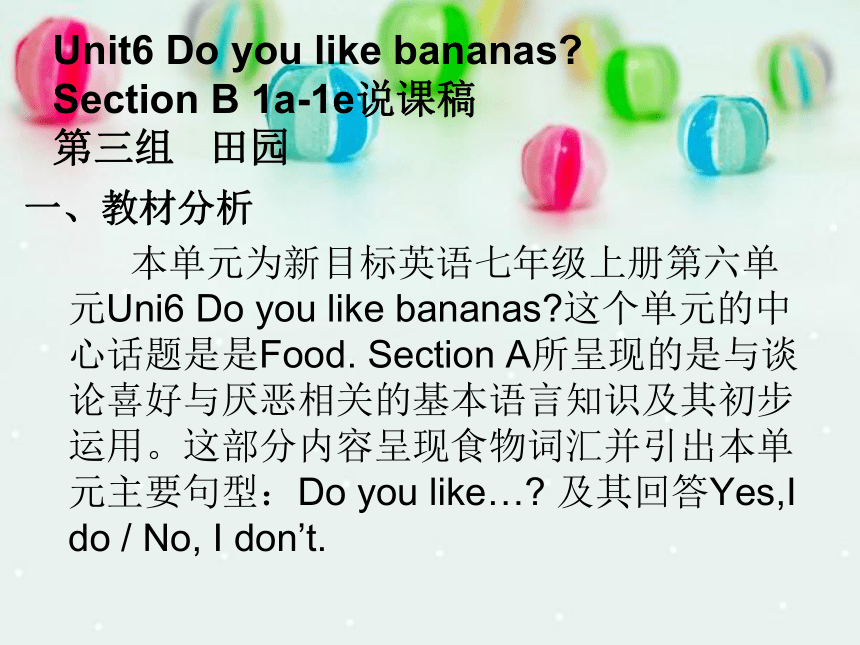 | |
| 格式 | ppt | ||
| 文件大小 | 2.1MB | ||
| 资源类型 | 教案 | ||
| 版本资源 | 人教新目标(Go for it)版 | ||
| 科目 | 英语 | ||
| 更新时间 | 2022-07-25 13:20:44 | ||
图片预览




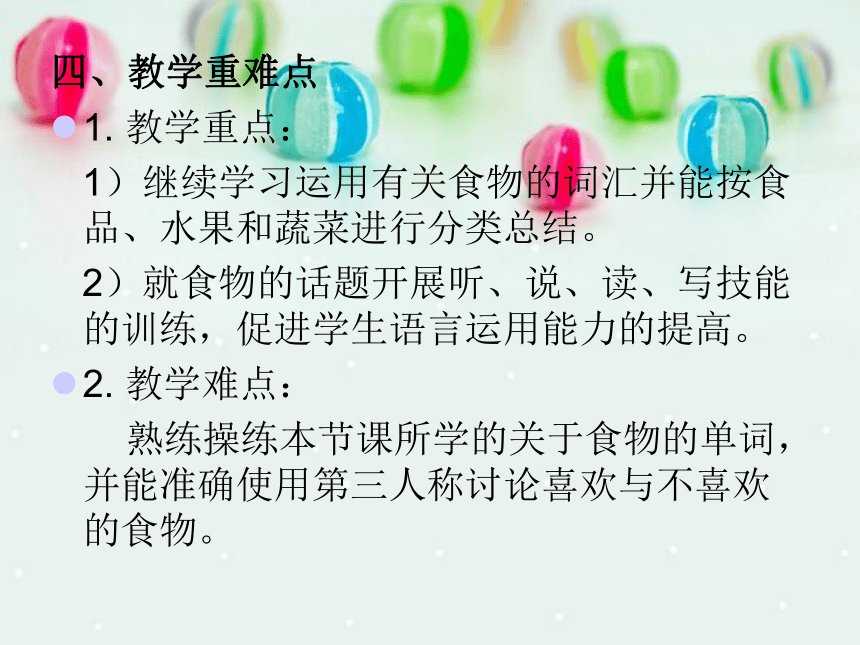
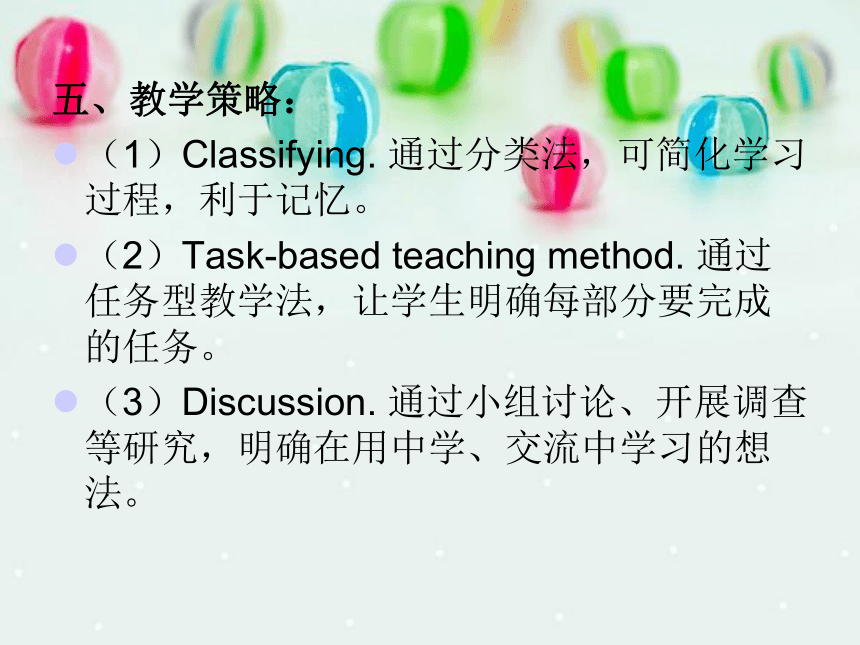

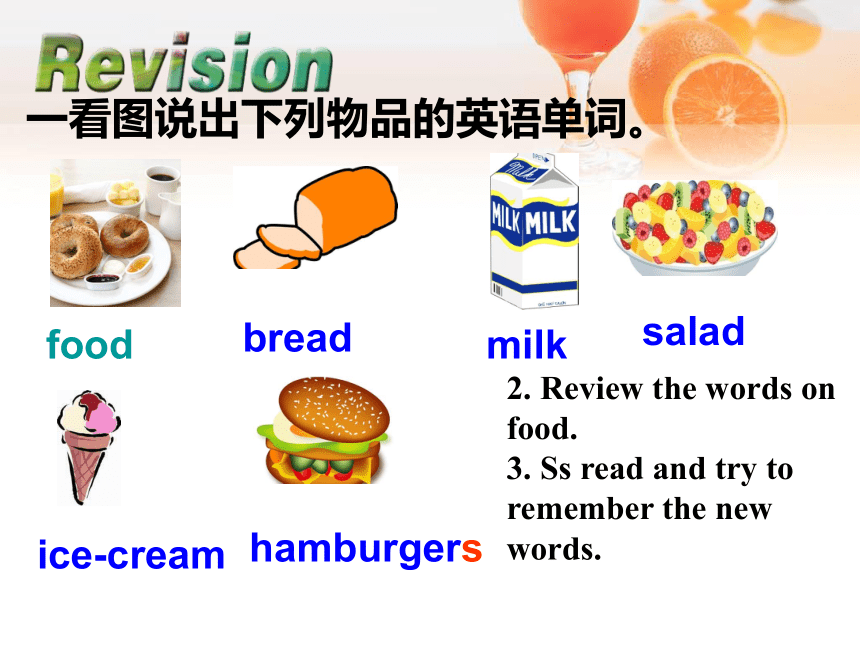
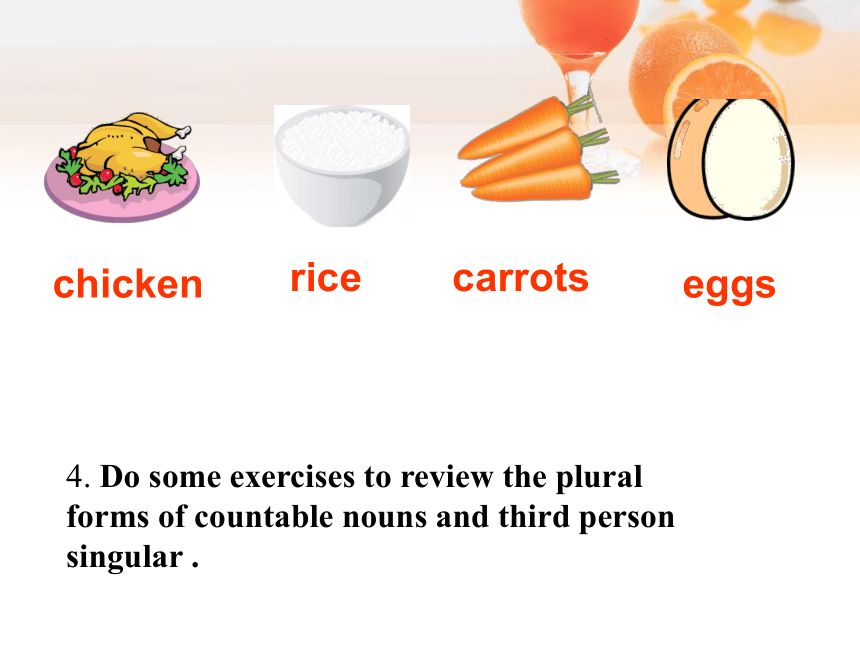
文档简介
(共23张PPT)
Unit6 Do you like bananas
Section B 1a-1e说课稿
第三组 田园
一、教材分析
本单元为新目标英语七年级上册第六单元Uni6 Do you like bananas 这个单元的中心话题是是Food. Section A所呈现的是与谈论喜好与厌恶相关的基本语言知识及其初步运用。这部分内容呈现食物词汇并引出本单元主要句型:Do you like… 及其回答Yes,I do / No, I don’t.
A部分教材设计了一个结对活动,以此操练主语是第三人称单数时句型的变化以及回答。我们说的Section B的1a-1e部分内容是Section A基础上的知识的扩展和延伸。该部分首先以听、说、写的形式展开了食物与名称配对以及对食物进行分类。接着设计了听力填写Sally和Tom喜欢与不喜欢的食物;自然引到了谈论一日三餐的话题的结对活动,实现了新旧知识的综合运用。主要语言功能项目是Talk about likes and dislikes. 语法结构为like的三单形式。
二、学情分析
该教材教学对象为初一年级学生,学生此时学习英语已经近半学期,他们已经掌握了一些词汇和句型,能够听懂一些简单的对话,英语已经入门。并且本部分主要内容是食物,这不仅贴近学生生活,而且能使学生产生浓厚的兴趣,学生感兴趣了,掌握起来也就更容易,为教师教学活动的开展提供了有利条件。
三、教学目标
1. 继续学习有关膳食名词:breakfast,lunch,dinner,egg,apple,chicken,fruit,vegetables;并能按食品、水果和蔬菜进行分类总结。
2.理解可数名词与不可数名词的概念,并能对所学的词汇进行分辨。
3.就食物的话题开展听、说、读、写技能的训练,促进学生语言运用能力的提高。
4. 该部分学习内容通过互相询问和谈论,可以培养学生对家人和同学、朋友的关怀和友爱之情。
四、教学重难点
1. 教学重点:
1)继续学习运用有关食物的词汇并能按食品、水果和蔬菜进行分类总结。
2)就食物的话题开展听、说、读、写技能的训练,促进学生语言运用能力的提高。
2. 教学难点:
熟练操练本节课所学的关于食物的单词,并能准确使用第三人称讨论喜欢与不喜欢的食物。
五、教学策略:
(1)Classifying. 通过分类法,可简化学习 过程,利于记忆。
(2)Task-based teaching method. 通过任务型教学法,让学生明确每部分要完成的任务。
(3)Discussion. 通过小组讨论、开展调查等研究,明确在用中学、交流中学习的想法。
六、教学过程
Ⅰ. Warming- up and revision
1. Greet the Ss.
food
bread
hamburgers
salad
一看图说出下列物品的英语单词。
milk
ice-cream
2. Review the words on food.
3. Ss read and try to remember the new words.
chicken
rice
carrots
eggs
4. Do some exercises to review the plural forms of countable nouns and third person singular .
Countable nouns Uncount-able nouns Countable and uncountable nouns
apples
bananas
pears
carrots
tomatoes
vegetables
eggs
oranges
milk
bread
rice
food
fruit
ice-cream
salad
chicken
hamburgers
strawberries
将下列单词按要求分类。
milk, orange, food, bread, egg, carrot, vegetable, rice, apple, ice-cream, strawberry, chicken, banana, salad, pear, bread, tomato, fruit
1. do (第三人称单数形式) _______
2. don’t (第三人称单数形式) _______
3. vegetable (复数) __________
4. hamburgers (同义词) __________
5. orange (复数) ________
6. like (第三人称单数形式) ________
7. egg (复数) ________
8. 食物 ________
9. 水果 ________
oranges
eggs
food
likes
fruit
does
doesn’t
vegetables
burgers
按要求写出正确的单词或词组。
purpose:通过展示食物图片,让学生复习所学过的食物单词及动词的第三人称变化规则,从旧知识过度到新知识,为本课做预热铺垫。
breakfast
lunch
1.提问引入生词
T: How many meals do you have every day
Ss: Three.
T:What are they (The students can answer them in Chinese.)
Purpose:教师通过提问引出并教授新单词,让学生会用英语表达“早餐”和“中餐”,同时为后面的环节做准备。
1. orange 2. salad 3. eggs 4. apple
5. ice-cream 6. hamburger 7. banana
8. chicken 9. rice 10. carrots
3
4
7
1a
Write the number of each word next to the correct food.
10
6
1
8
2
5
9
fruit: pears, ___________________________
_________________________________
vegetables: ____________________________
________________________________
strawberries
apples
bananas
1b
How many other words can you add to the lists
oranges
watermelon
grapes
carrot
tomatoes
potatoes
onion
broccoli
Purpose:让学生对刚学的新单词的进行复习,同时也回顾以前所学的旧单词,并对水果和蔬菜准确分类,从而为更好的完成1c,1d部分做充分的准备。
Listen and circle the food you hear in 1a.
1c
1. orange 2. salad 3. eggs 4. apple
5. ice-cream 6. hamburger 7. banana
8. chicken 9. rice 10. carrots
Listen again. Fill in the chart.
Likes Doesn’t like
Tom carrots
Sally
salad
apples
salad
bananas
oranges
vegetables
ice-cream
Purpose:1c部分学生主要任务是圈出听到的食物名称,侧重点是食物单词,任务较简单,所以放两遍听力即可。而在听1d部分前,先让学生快速浏览表格,明确要听什么信息,然后学生自听一遍,完成表格;最后再放录音,核对答案。这样能让学生便于在听的过程中弄清要求,抓住重点,掌握做听力题的方法。
1e
Does Tom like carrots
Yes, he does.
Does Tom like …
…
Ask and answer questions about what Sally and Tom like and don’t like.
Does Sally like salad
Yes, she does.
Does Sally like …
…
Purpose:学生能熟练操练本节课所学的关于食物的单词,并能准确使用第三人称讨论喜欢与不喜欢的食物。本环节,教师可建议学生多使用他们已掌握了的日常用语(如good morning,do you like… )更好的完成对话。
Unit6 Do you like bananas
Section B 1a-1e说课稿
第三组 田园
一、教材分析
本单元为新目标英语七年级上册第六单元Uni6 Do you like bananas 这个单元的中心话题是是Food. Section A所呈现的是与谈论喜好与厌恶相关的基本语言知识及其初步运用。这部分内容呈现食物词汇并引出本单元主要句型:Do you like… 及其回答Yes,I do / No, I don’t.
A部分教材设计了一个结对活动,以此操练主语是第三人称单数时句型的变化以及回答。我们说的Section B的1a-1e部分内容是Section A基础上的知识的扩展和延伸。该部分首先以听、说、写的形式展开了食物与名称配对以及对食物进行分类。接着设计了听力填写Sally和Tom喜欢与不喜欢的食物;自然引到了谈论一日三餐的话题的结对活动,实现了新旧知识的综合运用。主要语言功能项目是Talk about likes and dislikes. 语法结构为like的三单形式。
二、学情分析
该教材教学对象为初一年级学生,学生此时学习英语已经近半学期,他们已经掌握了一些词汇和句型,能够听懂一些简单的对话,英语已经入门。并且本部分主要内容是食物,这不仅贴近学生生活,而且能使学生产生浓厚的兴趣,学生感兴趣了,掌握起来也就更容易,为教师教学活动的开展提供了有利条件。
三、教学目标
1. 继续学习有关膳食名词:breakfast,lunch,dinner,egg,apple,chicken,fruit,vegetables;并能按食品、水果和蔬菜进行分类总结。
2.理解可数名词与不可数名词的概念,并能对所学的词汇进行分辨。
3.就食物的话题开展听、说、读、写技能的训练,促进学生语言运用能力的提高。
4. 该部分学习内容通过互相询问和谈论,可以培养学生对家人和同学、朋友的关怀和友爱之情。
四、教学重难点
1. 教学重点:
1)继续学习运用有关食物的词汇并能按食品、水果和蔬菜进行分类总结。
2)就食物的话题开展听、说、读、写技能的训练,促进学生语言运用能力的提高。
2. 教学难点:
熟练操练本节课所学的关于食物的单词,并能准确使用第三人称讨论喜欢与不喜欢的食物。
五、教学策略:
(1)Classifying. 通过分类法,可简化学习 过程,利于记忆。
(2)Task-based teaching method. 通过任务型教学法,让学生明确每部分要完成的任务。
(3)Discussion. 通过小组讨论、开展调查等研究,明确在用中学、交流中学习的想法。
六、教学过程
Ⅰ. Warming- up and revision
1. Greet the Ss.
food
bread
hamburgers
salad
一看图说出下列物品的英语单词。
milk
ice-cream
2. Review the words on food.
3. Ss read and try to remember the new words.
chicken
rice
carrots
eggs
4. Do some exercises to review the plural forms of countable nouns and third person singular .
Countable nouns Uncount-able nouns Countable and uncountable nouns
apples
bananas
pears
carrots
tomatoes
vegetables
eggs
oranges
milk
bread
rice
food
fruit
ice-cream
salad
chicken
hamburgers
strawberries
将下列单词按要求分类。
milk, orange, food, bread, egg, carrot, vegetable, rice, apple, ice-cream, strawberry, chicken, banana, salad, pear, bread, tomato, fruit
1. do (第三人称单数形式) _______
2. don’t (第三人称单数形式) _______
3. vegetable (复数) __________
4. hamburgers (同义词) __________
5. orange (复数) ________
6. like (第三人称单数形式) ________
7. egg (复数) ________
8. 食物 ________
9. 水果 ________
oranges
eggs
food
likes
fruit
does
doesn’t
vegetables
burgers
按要求写出正确的单词或词组。
purpose:通过展示食物图片,让学生复习所学过的食物单词及动词的第三人称变化规则,从旧知识过度到新知识,为本课做预热铺垫。
breakfast
lunch
1.提问引入生词
T: How many meals do you have every day
Ss: Three.
T:What are they (The students can answer them in Chinese.)
Purpose:教师通过提问引出并教授新单词,让学生会用英语表达“早餐”和“中餐”,同时为后面的环节做准备。
1. orange 2. salad 3. eggs 4. apple
5. ice-cream 6. hamburger 7. banana
8. chicken 9. rice 10. carrots
3
4
7
1a
Write the number of each word next to the correct food.
10
6
1
8
2
5
9
fruit: pears, ___________________________
_________________________________
vegetables: ____________________________
________________________________
strawberries
apples
bananas
1b
How many other words can you add to the lists
oranges
watermelon
grapes
carrot
tomatoes
potatoes
onion
broccoli
Purpose:让学生对刚学的新单词的进行复习,同时也回顾以前所学的旧单词,并对水果和蔬菜准确分类,从而为更好的完成1c,1d部分做充分的准备。
Listen and circle the food you hear in 1a.
1c
1. orange 2. salad 3. eggs 4. apple
5. ice-cream 6. hamburger 7. banana
8. chicken 9. rice 10. carrots
Listen again. Fill in the chart.
Likes Doesn’t like
Tom carrots
Sally
salad
apples
salad
bananas
oranges
vegetables
ice-cream
Purpose:1c部分学生主要任务是圈出听到的食物名称,侧重点是食物单词,任务较简单,所以放两遍听力即可。而在听1d部分前,先让学生快速浏览表格,明确要听什么信息,然后学生自听一遍,完成表格;最后再放录音,核对答案。这样能让学生便于在听的过程中弄清要求,抓住重点,掌握做听力题的方法。
1e
Does Tom like carrots
Yes, he does.
Does Tom like …
…
Ask and answer questions about what Sally and Tom like and don’t like.
Does Sally like salad
Yes, she does.
Does Sally like …
…
Purpose:学生能熟练操练本节课所学的关于食物的单词,并能准确使用第三人称讨论喜欢与不喜欢的食物。本环节,教师可建议学生多使用他们已掌握了的日常用语(如good morning,do you like… )更好的完成对话。
同课章节目录
- starters 预备篇(2012秋审查)
- Unit 1 Good morning !
- Unit 2 What’s this in English?
- Unit 3 What color is it ?
- Unit 1 My name's Gina.
- Section A
- Section B
- Unit 2 This is my sister.
- Section A
- Section B
- Unit 3 Is this your pencil?
- Section A
- Section B
- Unit 4 Where's my schoolbag?
- Section A
- Section B
- Unit 5 Do you have a soccer ball?
- Section A
- Section B
- Unit 6 Do you like bananas?
- Section A
- Section B
- Unit 7 How much are these socks?
- Section A
- Section B
- Unit 8 When is your birthday?
- Section A
- Section B
- Unit 9 My favorite subject is science.
- Section A
- Section B
